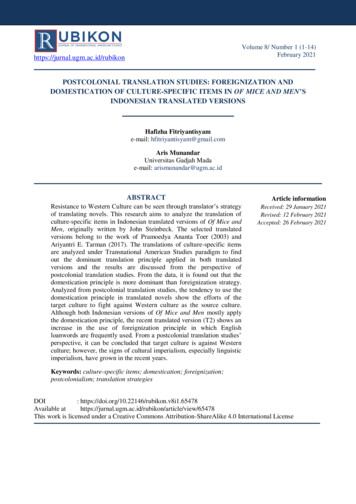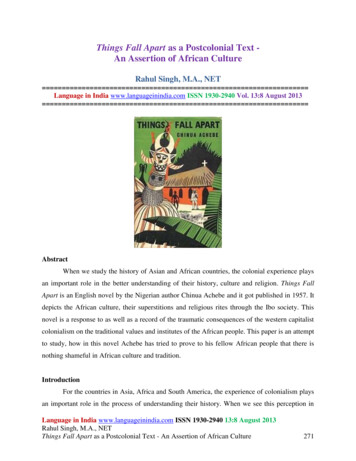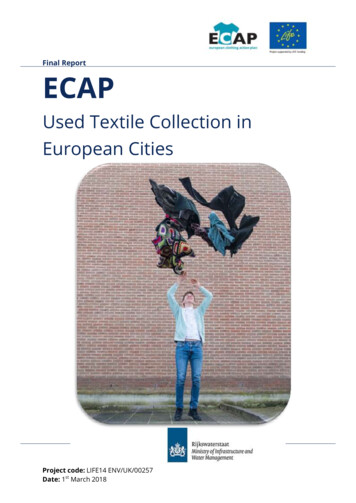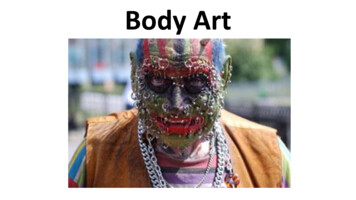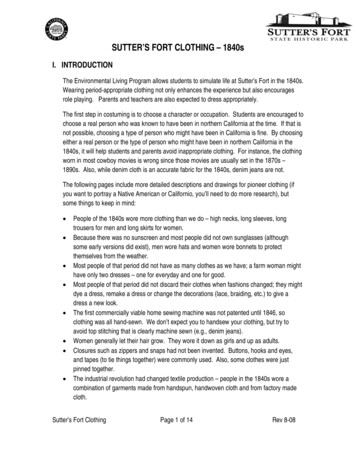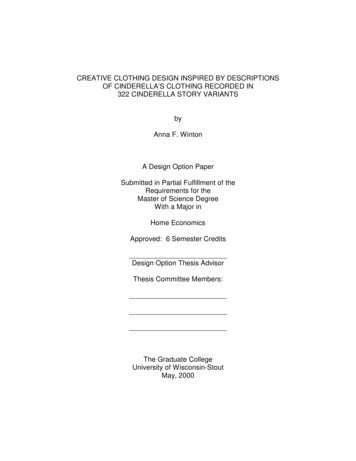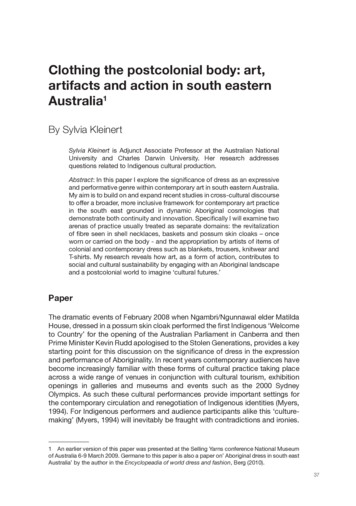
Transcription
Clothing the postcolonial body: art,artifacts and action in south easternAustralia1By Sylvia KleinertSylvia Kleinert is Adjunct Associate Professor at the Australian NationalUniversity and Charles Darwin University. Her research addressesquestions related to Indigenous cultural production.Abstract: In this paper I explore the significance of dress as an expressiveand performative genre within contemporary art in south eastern Australia.My aim is to build on and expand recent studies in cross-cultural discourseto offer a broader, more inclusive framework for contemporary art practicein the south east grounded in dynamic Aboriginal cosmologies thatdemonstrate both continuity and innovation. Specifically I will examine twoarenas of practice usually treated as separate domains: the revitalizationof fibre seen in shell necklaces, baskets and possum skin cloaks – onceworn or carried on the body - and the appropriation by artists of items ofcolonial and contemporary dress such as blankets, trousers, knitwear andT-shirts. My research reveals how art, as a form of action, contributes tosocial and cultural sustainability by engaging with an Aboriginal landscapeand a postcolonial world to imagine ‘cultural futures.’PaperThe dramatic events of February 2008 when Ngambri/Ngunnawal elder MatildaHouse, dressed in a possum skin cloak performed the first Indigenous ‘Welcometo Country’ for the opening of the Australian Parliament in Canberra and thenPrime Minister Kevin Rudd apologised to the Stolen Generations, provides a keystarting point for this discussion on the significance of dress in the expressionand performance of Aboriginality. In recent years contemporary audiences havebecome increasingly familiar with these forms of cultural practice taking placeacross a wide range of venues in conjunction with cultural tourism, exhibitionopenings in galleries and museums and events such as the 2000 SydneyOlympics. As such these cultural performances provide important settings forthe contemporary circulation and renegotiation of Indigenous identities (Myers,1994). For Indigenous performers and audience participants alike this ‘culturemaking’ (Myers, 1994) will inevitably be fraught with contradictions and ironies.1 An earlier version of this paper was presented at the Selling Yarns conference National Museumof Australia 6-9 March 2009. Germane to this paper is also a paper on’ Aboriginal dress in south eastAustralia’ by the author in the Encyclopeadia of world dress and fashion, Berg (2010).37
craft design enquiryNevertheless, by choosing to participate in these events on their own terms,Aboriginal Australians demonstrate the degree to which they understand andappreciate how to manipulate representations to their own advantage.In recent studies by Maynard (2000a, 2002) and Craik (1994) dress has emergedas central to understanding how clothing ‘as the private made public’ is pivotal tothe formation of individual and group identity. Dress, it is argued, has left behindits earlier association with fashion to assume greater complexity in relation tobroader global concerns that encompass ethnic and cultural identities. In herresearch, Maynard (2002) has productively contrasted the colonial provision ofgovernment blankets - initially as a form of conciliation - with the performativeuse of T-shirts in public protests as a public assertion of Aboriginal identities.It becomes clear that, for an ethnic minority entangled in the uneven powerrelationships of a settler society, the visibility politics of clothing is crucial tounderstanding the representation of Aboriginal identities within the widerframework of nation state.Aboriginality itself is crucial to this debate. Once defined in fixed essentialisingterms, cultural identity is today seen as ‘subject to the continuous “play”of history, culture and power’ (Hall, 1990, p 225). Identity in this sense is ‘amatter of “becoming” as well as of “being”’ (Hall, 1990, p 225). Thus culturalidentity arises from an Aboriginal cosmology that demonstrates both continuityand innovation. In using the term innovation, I am not referring to a modernistaesthetic of originality and individual expression.2 Rather, I draw upon recentstudies in cross cultural discourse (Morphy, 2008; Dodson, 2003; Glowczewski,1999; Ginsburg and Myers, 2006) in which Aboriginal cosmologies are definedin terms of continuities and discontinuities: concerned with the future as muchas the past (Hall, 1990, p 225). Thus Aboriginal culture follows its own distinctivetrajectories (Morphy, 2008), re-connecting with the past and creating newrepresentations, engaged in spiritual, moral and political terms both with anAboriginal landscape and a postcolonial world. By considering the significanceof dress as an expression of identity and difference and as a means of engagingin dialogue with a settler society, this essay argues that the visual politics ofclothing offers a broader, more inclusive understanding of contemporaryAboriginal art in south eastern Australia. Specifically it shows how art, as aform of action, contributes to social and cultural sustainability by reconnectingwith the past and resignifying in a postcolonial world to imagine cultural futures(Ginsburg & Myers, 2006)2 Morphy (2008, p 194) argues that accepting Aboriginal art as Indigenous modernism imposesconstraints which set Aboriginal art on an alternative trajectory determined by the modernist concernwith innovation and originality. When Aboriginal art is celebrated for its hybridity, this redirects theinterpretation of Aboriginal art away from its own Indigenous trajectory.38
Clothing the postcolonial body: art, artifacts and action in south eastern AustraliaPostcolonial bodiesDress carries particular resonance in south eastern Australia where two centuriesof colonisation have impacted on Aborigines. In the south east AboriginalAustralians were subject to unrelenting colonisation, devastated by disease andviolence, dispossessed from traditional lands and relegated to remote missionsand reserves. With colonisation Europeans brought their own understandings ofdress as part of the civilizing process of modern society: the adoption of clothingcodes was linked to class, gender and social mores which they proceeded toimpose on Aboriginal people. A crucial aspect of colonisation was the emphasisgiven to clothing as a mark of civilization. Maynard argues that the ‘absenceof clothing has been regarded dialectically as a lack of, or sign of, that whichexists outside the civilized’ (Maynard 2002, p 191). Thus clothing explicitlycirculates in the discourses of fear and admiration generated by a primitiveOther. To remedy this situation, colonial officials dispensed government clothingwith the result that, in the first decades of settlement, traditional clothing hadalmost completely disappeared. Nevertheless it should not be assumed thatthe dramatic interventions of colonisation, meant an unequivocal acceptanceof European dress. As I discuss elsewhere, what emerges is an uneven and yetcomplex process of social mediation across various exchange systems whereclothing served a range of interpretative possibilities within competing local,cultural and political agendas (Kleinert, 2010)In reality Aboriginal people in south eastern Australia had long been incorporatedwithin global processes. From the earliest arrival of European explorers,Aboriginal artifacts were traded as part of cross cultural exchange - widelyadmired and sought after as exotic curiosities. By the mid- nineteenth centurythe collections amassed by R. E. Johns would eventually be acquired by MuseumVictoria, but the basis of these collections was European: Johns sourced objectsfrom other collections, friends and family and salerooms but not directly fromAboriginal people (Griffiths, 1996, pp 28-54; Morphy, 1998, pp 319-320). Hencethese artifacts entered museum collections with little understanding of theirIndigenous context and their intrinsic value for Aboriginal people. MeanwhileAborigines continued to produce artifacts such as boomerangs, baskets andpossum skin cloaks for exchange and for sale to dealers and tourists. By the latenineteenth century however, anthropologists came to the belief that traditionalculture no longer survived in the south eastern Australia and as a consequence,these hybrid objects were dismissed as inauthentic tourist souvenirs (Phillips &Steiner, 1999; Morphy, 2008).This study is focused on the contemporary artistic expression which emergedin the south east during the 1970s and 1980s. With the repeal of discriminatoryand oppressive legislation in favour of policies that promoted self-determination,a new Aboriginal art movement emerged in the capital cities inspired by theBlack Power movement in Northern America and emerging pan-AboriginalLand Rights. Lin Onus (1948-1996), who led the genesis of a new Koorie artmovement in Melbourne, recalled the ‘new class’ of Aboriginal people who39
craft design enquiryemerged to public attention in the late 1960s: ‘Many were young, many werearticulate, but they were all angry’ (Onus, 1993, p 290). At the time a numberof important exhibitions like Koori Art ‘84 at Artspace in Sydney played aseminal role in bringing artists together. Subsequently Aboriginal controlledorganizations began to emerge such as Boomalli Aboriginal Artists Cooperativeestablished in 1987 by a group of young Aboriginal art students to provide anetwork of support for young artists through a gallery space and exhibitionssuch as True Colours (1994-5) and Blakness: Blak City Culture (1994-5) whichbegan to redefine Aboriginality.It was not until the 1980s however that a parallel renaissance occurred amongAboriginal women in the south east.3In the catalogue for the groundbreakingAboriginal Women’s Exhibition in 1991 Indigenous writer Henrietta Fourmile(1991, pp 4-5) identified several reasons for this delay: a patriarchal bias onthe part of anthropologists who failed to acknowledge Aboriginal women’scomplementary role in society;4 art/craft debates which relegated women’spractice to the anonymous realm of craft and the impact of Aboriginalstereotypes which dismissed Aborigines in the south east as having ‘lost’ theirculture by comparison with ‘real’ Aborigines in northern Australia. In response,she argued, women preferred to focus on the production of traditional fibreitems such as baskets, shell necklaces and printed textiles.5Thus contrasts canbe drawn between the tough, oppositional art of the cities where (male) painterspredominated6 and the revitalisation of an intercultural and collaborative fibrepractice through workshops and exchange programs led by senior womenlocated in small, sometimes relatively isolated rural communities.7 Indicative ofthe emerging fine art status of fibre practice is the inclusion of Ngarrindjeri artistYvonne Koolmatrie’s eel traps in Fluent, the 1997 Venice Biennale, alongsidethe paintings of Emily Kame Kngwarreye and Judy Watson and, in 2005, the3 Key exhibitions are: Women’s art exhibition (1991); Women’s Work: Aboriginal women’s artifactsin the Museum of Victoria (1992); Tactility: Two centuries of Indigenous objects, textiles and fibre(2003); Twined together: Kunmadj njalehnjaleken (2005); Woven forms: contemporary basket makingin Australia, (2005) and Recoil: change and exchange in coiled fibre art (2007).4 The research of Lesley McCall (1988) confirms the androcentric bias in the Museum Victoriacollection.5 West points out that, in addition to funding from the Aboriginal Arts Board of the AustraliaCouncil for the Arts, the Crafts Council of Australia also directed funds toward the development ofIndigenous programs and exchanges in Northern Territory, Western Australia and South Australia(2007, p 13)6 For example in Koori Art ’84 of the nineteen ‘urban’ Aboriginal artists represented only fiveare women. However these gender distinctions may also be an effect of Western categories. InEuropean art history the category of craft is directly connected with women (Parker 1984) whereasthere is ample evidence of men’s contemporary and historical involvement in fibre practice (Mellor& Hamby, 2000; Wood-Conroy, 2000).7 See, for example, Two Countries: One Weave (1992) which bought together Ngarrindjeri womenfrom the Riverland region of South Australia and women from Maningrida in Arnhem Land (Mellor& Hamby, 2000, pp 372-373). Exchanges have occurred since through the Batchelor Institute ofIndigenous Tertiary Education in Alice Springs, and Tennant Creek and through workshops in theWestern Desert and Western Australia (West, 2007, pp 24- 25, 31, 45)40
Clothing the postcolonial body: art, artifacts and action in south eastern Australiaprizewinning almost life-size Tjanpi Grass Toyota created by women fromBlackstone community, Western Australia for the Aboriginal and Torres StraitIslander Art Award.Recent studies in cross cultural discourse (Morphy, 2008; Myers, 1994; Philips &Steiner, 1999) have explored the way in which anthropological and art historicalcategories of art/artifact and art/craft have consistently defined Aboriginal artin European terms.8 In charting the shift from primitive art to contemporaryIndigenous art, their insights demonstrate the way in which processes of valuecreation have generated national and international recognition for Aboriginalart. But the problem is that the majority of this writing and related exhibitionsis focused on northern Australia – in effect, reinforcing colonial discourses ofrace and culture (Gibson, 2008; Allen & Greeno, 2005, p 17). Since the 1970s,the development of acrylic dot painting in Central Australia has contributed tothis separation, enhancing the status of Aboriginal art and culture as a uniquesymbol of national identity. Although the remote/urban dichotomy has beenquestioned, it is clear that for Aborigines in the south east, the effect andexperience of these colonial categories can be internalised as a sense of lossand expressed as a profound ambivalence (Gibson, 2008).9 Nevertheless it isimportant to acknowledge the diversity of Aboriginal experiences in relation toparticular geographic, historical and material circumstances and generationaldifferences. We need to acknowledge that Aboriginality proceeds througha complex repertoire of critical strategies and articulations ‘at times ancient,at times subversive, at times oppositional, at times secret, at times shifting’(Dodson cited by Grossman 2003, p 5).This study aims to build on and expand cross cultural discourse in relation tocontemporary Aboriginal art in south eastern Australia. In the following section Iwill begin by examining some of the objects –once worn or carried on the body- produced in the revival of fibre practice before looking at the appropriation ofEuropean items of dress by city-based artists. Obviously I in no way suggest thatthese two strands do justice to the complexity and diversity of contemporary artpractice in the south. Rather I argue for a broader, more inclusive understandingof contemporary Aboriginal art in the south east. While each strand appearsto be a discrete domain with its own distinctive trajectories, in reality, thisseparation is the outcome of deeply entrenched Western categories which haveserved to mask the many commonalities and interconnections -expressive of anintegrated and holistic Aboriginal worldview.8 Morphy (2008, p 12) argues that ‘Art as a category is deeply entangled in value creation processes.Since the eighteenth century, the category of fine art has been used to exclude recognition for otherart forms.’9 The loss felt in relation to development is not of course restricted to south east Australia. SeeMerlan (1989).41
craft design enquiryRenewal and revitalisationSince the 1970s with the greater freedom offered by policies of self-determination,Aborigines across south eastern Australia embarked on a remarkable processof cultural revival in language, law and culture. Driven by an imperative needto redress a sense of loss and elation at the opportunity to re-engage with thepast these cultural revivals have assumed various forms: re-connecting withCountry, establishing relationships with remote communities and participatingin workshops and exchange programs. Nevertheless there is a sense in whichthese cultural revivals are frequently misunderstood and may be read by thewider community in potentially damaging ways as a fabrication or an illusionof identity (Gibson, 2008; Kuper, 2003). Therefore there is a pressing needfor studies like that undertaken here which examine the way in which culturalrevivals proceed. Far from being a mere replication of the past, cultural revivalsinvolve a complex process of recreation and transformation, proceeding byway of memory and history and narratives of identity and experience that carrypolitical, moral and cultural force.Fibre has always played a central role in the productive activity of AboriginalAustralians. Across the south east, plant and animal-based fibres were spunand coiled into structures that fulfilled a diverse range of functions in bothspiritual and material terms.In many cases items of dress encoded complex meanings as markers ofindividual identity in relation to social hierarchies, age and gender. For instance,a possum skin cloak used as protection against inclement weather, to carryweapons and for women to carry babies, also served as a marker of individualand group identity. In death, as in life, the individual’s possum skin cloak, togetherwith other personal items such as woven baskets, tools and food, ensured asafe return of the spirit to the ancestral domain. Drawings by Wurundjeri artist,William Barak, depict men dancing in ceremony wearing cloaks like a protectivemantle accompanied by women seated with clap sticks and possum skincloaks rolled tightly across their knees as drums. For Aborigines, the creativityand effort involved in the production of these items was invested with intensemeanings as part of a hunter-gatherer lifestyle with its own well establishedexchange relations. Despite the lack of interest on the part of institutions andtheir exclusion from discourses of Aboriginality, Aborigines in southeasternAustralia never ceased to be involved in the cultural production of items suchas boomerangs and baskets. Aborigines in the south east express concernwith ‘keeping culture’: in the process of transmitting the knowledge and skillsrequired to gather and prepare materials and create a boomerang or basket,children learn respect for Elders, listen to the stories of their people and gainaccess to their cultural heritage.Under the impact of assimilation policies - in place for the better part of thetwentieth century – government policies sought to erase cultural life. In relayingtheir historical experiences Aboriginal people recall being punished for speaking42
Clothing the postcolonial body: art, artifacts and action in south eastern Australialanguage and passing on skills and knowledge. Unsurprisingly many Aboriginalpeople chose not to pass on their cultural knowledge. Yet Aboriginal culturesurvived. Gundidjmara woman Connie Hart (1917-1993) recalls that ‘No onetaught me to make my baskets. I used to watch my mother do it My Mum toldme that we were coming into the white people’s way of living. So she wouldn’tteach us’ (Griffiths, 1996, pp 279-281). However forty years later, after her motherhad died, Connie Hart felt free to make her first basket and later conductedworkshops at the Hamilton Keeping Place in western Victoria. Likewise thecultural revival of Ngarrindjeri weaving can be attributed to the initiative of asingle custodian, Doreen Kartinyeri (1935-2007) who, in 1982, establishedworkshops at Raukkan (Point McLeay) and Menindie for the Ngarrindjeri of theLower Murray, the Coorong and Lake Alexandrina region of South Australia.Yvonne Koolmatrie and Ellen Trevorrow attended these workshops and eachwent on to a distinctive career.Plate 1: Lola Greeno, Untitled Shell necklace, 2006, maireener and oat shells. 180cm inlength, Reproduced with permission of the artistIn Tasmania, where Trucanini (Truganini) stands as an ironic symbol of colonialnarratives of extinction, the continuous production of shell necklaces is cause forgreat celebration (Greeno ,2006). (Plate1) Such steadfast cultural continuity in theface of genocide testifies to the resilience of Aboriginal Tasmanians. For womenliving in exile on Flinders Island, the production of shell necklaces representedan important means of economic survival, sold or bartered to provide food andclothing for their families. Yet, even today, the complex knowledge and skillsrequired to make shell necklaces are tightly held, a precious secret restrictedto certain key families and passed down from one generation to another frommother to daughter. Using long strands of up to almost two metres in length,the artists create distinctive patterns from various types of shells collected fromdifferent sites. Today the shell necklaces fulfill multiple roles that traverse publicand private domains. In homes, necklaces draped over family photographs offer43
craft design enquirya symbol of love and protection; in a public context, they feature in ceremonies,in workshops and in the community festivals putalina and larapuna (Greeno,2006, p 54). With emerging fine art status, contemporary shell necklaces, whosebrilliant shimmer brings comparison with northern Australia (Morphy, 1992), aretoday highly sought after as prestigious items commissioned by private andinstitutional collections.Nevertheless as objects traverse the colonial categories of art/artifact and art/craft tensions and ambiguities inevitably arise. Lindy Allen and Lola Greenowriting in a catalogue essay for the exhibition Woven Forms: ContemporaryBasket Making in Australia, examine the range of productive activity incontemporary fibre practice and its critical response. They draw contrastsbetween the work of senior custodians, who produce ‘cultural pieces’ (like thecoiled ‘sister baskets’ unique to the south east)10 which may have personal,historical and cultural resonance and the production of individual andexpressive objects that are seen to ‘push the boundaries of the medium’ (Allen& Greeno, 2005, p 19).11 The upshot is that the ‘cultural pieces’ where the artisthas followed historical templates are relegated to the museum while the moreindividual work is applauded and given considerable recognition as an artwork‘which only ever allows a one-dimensional, aesthetic judgment’ (Allen & Greeno,2005, pp 20- 21). It is clear from this discussion how the value judgmentsimplemented through Western categories and market forces impact on theeffect and experience of contemporary fibre practice. But in the process, asHoward Morphy points out (2008, p 194), tradition and innovation are located inopposition, in effect creating two separate categories.12 An alternative viewpointwould argue that within Aboriginal cosmology there exists both continuity andinnovation. From this perspective both ‘cultural pieces’ and art works contributeto cultural cohesion and sustainability by rebuilding communities and by gainingrecognition for a dynamic and resilient Aboriginal presence. Above all thesesomatic objects resonate in relation to an Aboriginal landscape in terms of theirtexture and smell, their connection to people and place and to an ancestral10 An historical precedence exists for the transfer and exchange of fibre techniques. In 1922missionary Gretta (Margaret) Mathews, who had previously learned coiling from Ngarrindjeri women,introduced the coiling technique to the Methodist Mission at Goulburn Island (Warruwi) (West, 2007,pp 14-15; Mellor and Hamby 2000).11 In tracing the history of the efflorescence in fibre art, West observes that support by the CraftCouncil of Australia focused on ‘adapted’ craft rather than ‘customary’ weaving (2007, p 13). It isinteresting to note that in Recoil (2007), two of the most innovative fibre artists in the south east areincluded, but no ‘customary’ weaving.12 As Nicholas Thomas argues ‘Curators and anthropologists have become notorious forfetishizing traditional culture to the exclusion of those cultures’ historically adapted and innovativeexpressions’ (Thomas, 1999, p 197). Thomas succintly captures the way in which western discoursessustain an apparent opposition between a reified tradition and innovation. He continues: ‘Thesignificance and effects of Indigenous art can only be misunderstood if we insist on celebratingeither the so-called ‘traditionalist’ expressions or the ‘contemporary’ ones instead of acknowledgingboth’ (Thomas, 1999, p 199).44
Clothing the postcolonial body: art, artifacts and action in south eastern Australiadomain embodied in the repeated actions of gathering and preparing the reedsand grasses, and proficient use of their hands to weave aesthetically attractiveobjects (Lamb, 1996, p 53).13Plate 2: Lorraine Connelly-Northey, An O’possum - skin Cloak, 2005-6, rustedcorrugated iron, wire, 119.5 x 131.5 x 5.0 cm. Collection: National Gallery of Victoria,Melbourne. Reproduced with permission of the artist.Thus cultural renewals may take many forms. In 1993, a workshop at theQueen Victoria Museum and Art Gallery in Launceston initiated a revival in fibrepractice including the tradition of kelp water carriers unique to Tasmania. Whilemany artists continue to make grass baskets and kelp water carriers followingtraditional models, Vicki West transforms the bull kelp that grows around therugged shoreline of the island into an entirely new object. West observes that‘Lots of my work is about the survival of culture and celebrating that survival –13 Lamb (1996, p 53) and West (2007) provide an insight into Koolmatrie’s engagement with thelandscape. As Yvonne Koolmatrie says, ‘I’m very close to the river [the Murray] although I comefrom the Coorong I couldn’t survive without water. It’s beautiful, it inspires me. I go through all thesites: the middens, canoe trees, the burial sites. I care for the land and the people who have beenhere. They’ve walked along the banks and pulled rushes where I’m pulling them and it just inspiresme’ (West, 2007, p 95).45
craft design enquirypast, present and future’ (Reynolds, 2006, p 43). Like a piece of armour, handsewn and improvised to meet an unforeseen enemy, West’s Kelp Armour (2003)apparently bears the scars of battle, shot through and shredded to ribbons.As such it is a powerful reminder of the guerilla warfare staged by Tasmanianpeople, effectively undoing the settler colonial myth that Aboriginal peoplesimply melted away before the tide of civilization, or were decimated by illness,thereby whitewashing the violent battles in which Aborigines engaged. In KelpArmour West draws creatively upon the heritage of her people but she is alsooperating counter- discursively, challenging authorised versions of colonialhistory.An alternative political reality acknowledges that Aborigines and non-Aborigineslive in a shared co-existence within a settler colonial society (Kleinert, 2002). ForWiradjuri artist Lorraine Connelly-Northey it is a relationship to be negotiated.Since 2002 she has recreated the string bags, possum skin cloaks and coolamonsof an earlier era but in alternative materials, using the industrial detritus of themodern world: rusted iron, barbed wire and coils of wire. (Plate 2) In so doing sheseeks to pay respect to both her mother’s Indigenous connections with Countryand her father’s Irish descent, living on the land following a vernacular traditionof making do and improvisation. Born in Swan Hill, Lorraine Connelly-Northeyinitially worked in Adelaide and attended a workshop with renowned weaverYvonne Koolmatrie. But she did not want to follow Koolmatrie by working in atraditional style of weaving and, as a Wiradjuri woman, she was not comfortableusing local cummbungi grasses out of respect for the traditional owners, theWemba Wemba (Murray, 2003). Artistically, Lorraine Connelly-Northey aims todo something distinctive and different - something innovative that really standsout (Connelly-Northey, 2009). Like Lena Yarinkura from Bolkdjam in Arnhem Landwho has gained renown for her Yawkyawk (Mermaid) figures, Lorraine ConnellyNorthey wants to be innovative. The trajectory on which she is embarked isengaged in the effort of reworking discarded materials to create objects of greatbeauty - artworks that speak of being both black and white, taking from both tocreate a future imaginary.The recent revival of possum skin cloaks by four young artists Lee Darroch,Treahna Hamm and Vicki and Debra Couzens born in the 1960s and 1970s,provides further evidence of the complexities entailed in cultural revival(Reynolds, 2005). (Plates 3 & 4) In 1999 the four artists embarked upon a projectto reproduce the two remaining possum skin cloaks in Australia held in theMuseum Victoria collection:14 the Lake Condah cloak collected in 1872 andthe Maiden’s Punt (Echuca) cloak collected in 1853.15 With reproduction cameconsiderable responsibility. With due respect for cultural protocols the artistsengaged in consultation with elders in the relevant communities concerning thecultural significance of the cloaks, the meaning of the geometric and figurative14 The remaining four cloaks and one engraved possum skin pelt are in collections overseas(Reynolds, 2005, p 62 fn 1).15 The project which included possum skin cloaks and prints was funded by the National Museumof Australia. The artists named the project Tooloyn Koortakay or ‘squaring the skins for rugs.’46
Clothing the postcolonial body: art, artifacts and action in south eastern Australiadesigns etched inside the cloaks and the story telling they generated. Eventhen the process of reproduction raised unforeseen problems which requiredadjustments and modifications. Where elements of the design were missingfrom th
given to clothing as a mark of civilization. Maynard argues that the ‘absence of clothing has been regarded dialectically as a lack of, or sign of, that which exists outside the civilized’ (Maynard 2002, p 191). Thus clothing explicitly circulates in the discours

